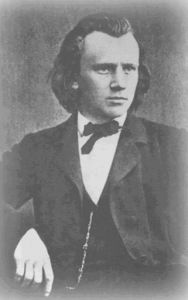
Johannes Brahms (1833 – 1897)
When Brahms published this first of his symphonies in 1876, he was already 43 years old, rather late for a classical music giant in the Romantic era. What’s more astonishing is that this symphony took about 15 years to complete. It’s easy to understand that this delay was probably because he felt the insurmountable high standard cast upon him by Beethoven was difficult to achieve, and also because Brahms himself was a perfectionist.
Nevertheless, Beethoven’s influence on Brahms’ first seems evident. Most notably, the “fate” motto of Beethoven’s Fifth Symphony that is prevalent in the first movement, the resemblance between the finale’s main melody and the “Ode to Joy” in Beethoven’s Ninth.
Though very much respecting the classical form of symphonies prior to his time, Brahms’ first symphony embodies dramatic intensity and deep emotions.
1. Un poco sostenuto - Allegro
The first movement overall is forceful and energetic. It’s in sonata form, with an extended introduction (Un poco sostenuto) that begins with constant timpani hammering out the beats (part 1), along two lines of melodies, upward violin and descending woodwind, “tearing” apart (as Leonard Bernstein described), seemingly to express deep emotional struggle, yet so overwhelmingly powerful:
It is followed by another phrase (part 2) led by oboe, which is then referenced during exposition:
Theme 1 starts with an abrupt timpani call into the Allegro part of the movement, obviously derived from the opening line:
While elaborating the main theme and transitioning to 2nd theme, we hear the “fate” motto on the accompanying violin:
Theme 2 is also on oboe and echos part 2 of the introduction:
Even during exposition, in between of the two themes, elements of the themes are taken out and constantly being reiterated, extended, transformed and developed, with changing rhythms and contrasting dynamics. Take a listen to the passage at the end of exposition where theme 1 turns marching forcefully with leaping syncopation along the way:
The overall impression we get while listening to this movement, and, really all Brahms’ symphonies, is that presentation and development of themes are not as clearly marked and easily identifiable as pieces from classical times; yet, overall the work still maintains its footing in the classical forms.
It’s worth noting the references Brahms made to Beethoven’s “fate” motto again development:
and carried it all the way through end of the coda and thus the movement:
2. Andante sostenuto
The second movement is in A-B-A ternary form, filled with heart-melting reflection and melancholy. The part A1 opens on the strings:
The following part A2 on solo oboe is lyrical with sweet tranquility:
The middle section B presents two corresponding parts that are mostly derived from the respective themes in section A, sounding a bit more lyrical and brighter in color, and staying on the same instruments of their counter parts as well:
B1:
B2:
When A part returns, theme A2 is now repeated by solo violin, echoed by the horn, the sound feels more expressive than it is initially played by solo oboe:
3. Un poco Allegretto e grazioso
The 3rd movement continues with a generally soft and pleasant mood, in a ternary form again but with a trio in the middle. While overall structure is Allegretto – Trio – Allegretto reprise, the Allegretto itself seems to be in ternary form as well, therefore making the whole movement like a “compounded ternary” form. This is just another example of how deeply devoted Brahms was to the classical spirit.
The Allegretto section in 2/4 time presents a few theme parts; first part has two themes, part A starts on a peaceful melody on clarinet:
That calmness was immediately answered by a playful phrase on flute, which is part B:
In the middle part, a pair of themes form a contrasting part against A+B, mood is more swift and jumpy, with a denser rhythm underlying the melodies played by clarinet and then oboe:
Part C:
Part D:
After a shorter repeat of A, the movement enters the Trio section, which is in 6/8 time:
After the trio, themes A and B were repeated with variation before ending the movement with a short coda.
4. Adagio - Piu Andante - Allegro non troppo ma con brio
Brahms puts a more extensive introduction in the finale than the first movement. The Adagio section contains the dramatic 1st theme that opens on the strings, with similar ascending notes like the main theme coming in the Allegro but in much darker mood filled with anxiety:
The theme develops more with mystery and tension, but then soon gets all wiped away by the grand horn call of a powerful melody, the famous “alphorn” tune (beginning the Piu andante section), like a shred of bright sunlight piercing through the clouds:
This unforgettable tune is repeated by the solo flute, and followed by a solemn chorale:
After brief repeat of the alphorn tune, enters the grand main theme, which is much reminiscent of Beethoven’s “Ode to Joy” in his Ninth Symphony:
The 2nd theme sounds same as the main theme in spirit:
The chorale theme is heard in the coda section near the end, but how has become a fantastic proclamation of glorious joy with a high sense of unity:

